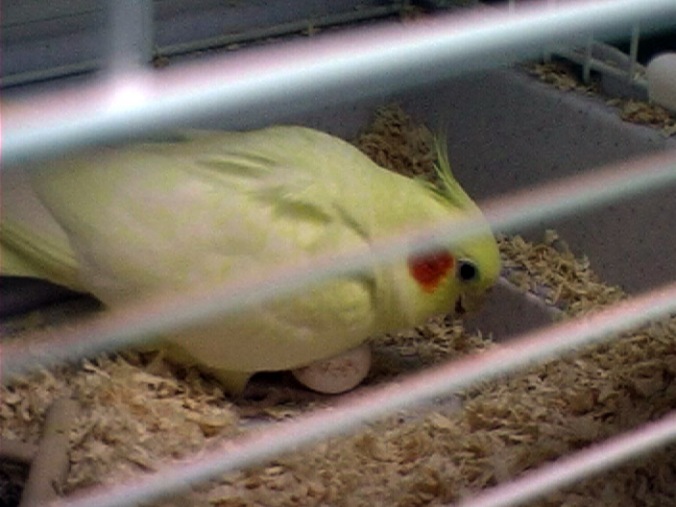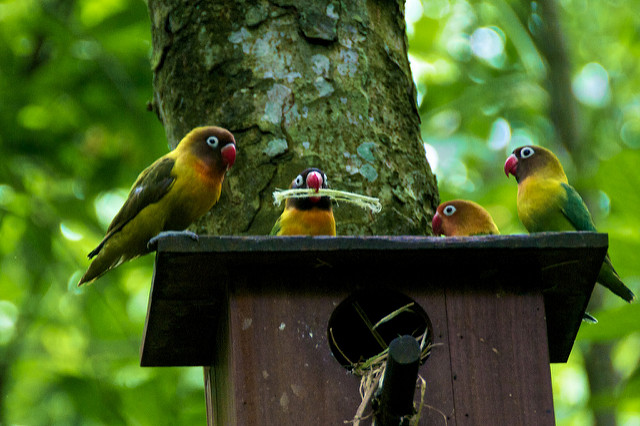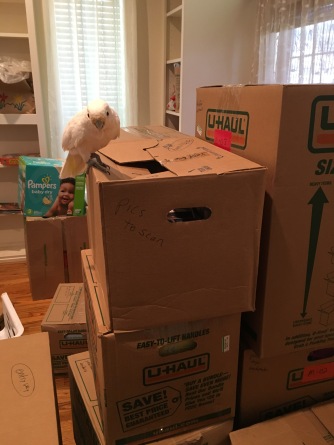Hormones can be the cause of many behavior problems in birds. As a breeder it is very easy for me to identify mating behaviors for what they are. However, most pet owners do not breed and are therefore unfamiliar with typical mating behaviors and their common triggers. Instead they anthropomorphize such behaviors and let things escalate too far. It is essential that you learn everything you can about the particular species that you own- including how they breed. Even if you never plan to breed, those behaviors are embedded in your pet’s DNA. You need to understand what’s going on in order to prevent unwanted hormonal behaviors.

A pet cockatiel laying infertile eggs. Photo by Adrian Ward.
What happens when mating behaviors are triggered in pet birds?
- Aggression, even toward favorite people
- Territoriality
- Excessive screaming
- Plucking
- Frustration and lashing out
- Egg laying (which can lead to egg binding)
Behaviors like the above often lead to rehomed pets. Back when I first got into birds, you could flip to any pet classified section and see ad after ad for birds around 2-4 years of age. Depending on the species, this is when puberty hits. After years of receiving mixed messages, the birds were finally ready to mate. The problem was that they wanted to mate with their favorite person and started lashing out when their owners weren’t responding predictably.
Plucking, while not usually dangerous, can easily become a habit that is very difficult to break.
Excessively egg laying can be dangerous, particularly if the hen isn’t on a proper breeding diet (most pets are not, nor should they be). When an egg becomes trapped inside the body there is a risk it will rupture, causing a life-threatening infection. Preventing hormonal behaviors in pets is especially important for hens. If your bird is already laying excessively, please see my article on egg laying in pets.
Breeding Triggers
The following are some common ways that breeding can be inadvertently stimulated. Please keep in mind that this list is not exhaustive. Every species is different and it is important to understand how your birds would normally nest.

Photo by Dan Armbrust.
Dark, Enclosed Spaces
Most parrots are cavity breeders- they nest in tree trunks. Pairs will seek out a good cavity, clean it out, and possibly enlarge it. In the modern home any dark, enclosed space will be viewed as a potential nest site. This could be under the couch (see below) or dresser, inside a Happy Hut or tent, a shipping box offered for chewing, or under a blanket. It is important never to offer any item, particularly inside the cage, which could be viewed as a nest site. Troublesome areas (like under the couch) should be blocked off or made off-limits.
Above: (Left) A gap in a couch is a tempting nest site, and potentially dangerous as this couch reclines. (Right) Moving/shipping boxes may offer chewing fun, but they are also seen as nest sites. Loki kept attempting to enter this one.
Nesting Material
Cleaning the nest cavity is a normal part of nest preparation. Some breeders have even found that introducing large chunks of wood into a nest box will help stimulate their pairs. In pets, stredding can be a prelude to nesting. Lovebirds in particular use nesting material. Leaves are tucked into the rump feathers and transported back to their nest site. Quakers build huge communal nests with sticks.
Birds should never have access to the substrate in their cage, but nevertheless may try to shred everything they get their beaks on. Shredding is fine and destructible toys are good, but during the breeding season you may want to offer alternatives if your bird is prone to nesty behavior.

Black-masked lovebirds. One of the few psittacines that uses nesting material. Photo by Dean Croshere.
Light
Longer days simulate springtime. Many owners keep their birds up after dark, making long days even longer. Birds need at least 10 hours of sleep and I would extend that to 12-14 if they are getting hormonal. Cover your bird’s cage or give them a separate sleep cage in a quiet area to ensure they’re getting enough darkness.
Feeding Soft, Warm Foods by Hand
Bonded pairs regurgitate to one another. Offering treats by hand when training is fine, but try to avoid hand feeding warm, mushy foods. Feed them in a dish. If your bird regurgitates don’t encourage it.
Too Much Protein
Chicks require a lot of protein to grow, and providing birds with too much protein signals that it’s a great time to raise a family. If you have a hen that is already laying eggs you do want to continue offering protein and calcium (especially calcium) so that she is less likely to deplete her own reserves. If your pet is not laying eggs then continue to feed a good diet but do not make a habit of offering a lot of protein. Calcium in the form of pellets, cuttlebone, or mineral block should be offered year-round, especially to hens.
Providing Sexual Stimulation
Mating usually involves the male doing some sort of display- head bobbing, pinpointing eyes, flaring tail or wings. When the female is ready to mate she droops her wings and raises her rump. The male typically mounts her (some species will mate side by side) and they rub their cloacas together. The cloaca is the opening underneath the base of the tail. It is used for passing feces, uric acid (bird equivalent of pee), eggs, and for transferring/receiving sperm.

Cockatiels mating. Note the posture of both birds. Male is one top and female is on bottom. Photo by dorisalb.
Many of the ways you touch your bird could be interpreted sexually. Mutual preening (head scratching) can be done by flockmates but it is more common in bonded pairs. Petting your hen on the back can be stimulating, as she feels like you are trying to mount her for mating. Touching the cloaca should definitely be avoided. Some birds get excited when pet under the wings.
Always be aware of your bird’s body language while petting them. If they are exhibiting postures like those in the picture above, stop petting them as they are getting sexually stimulated. Males will usually pinpoint their eyes, dip their head, and raise their wings at the shoulder a bit. Hens will raise their rump, drop their wings and coo or shiver. Give them a period to calm down before petting again.
It is entirely possible that your bird will try masturbating on you. This may involve mounting your hand and rubbing the cloaca (in males) or backing up against you and rubbing the cloaca (in females). Masturbation should neither be encouraged nor discouraged directly. If your bird is trying to mate with you, simply move it to another location or place it back into the cage for a while.
Sometimes the object of affection is a toy. Never offer your pet a mirror or fake bird. Birds can become very attached to these items and defend them aggressively. If, however, a bird is masturbating on a wide variety of objects/toys I would be less concerned.

Goffin hen masturbating on toy. Click here to see video. It’s a very good example of how hens behave.
My Goffin is actually trying to self-stimulate as I write this. Observe:

This may seem innocuous to you- most pet owners would probably think so- but pay attention to her body language. Her eyes are half-closed, beak half-open, and she has a blissful expression. Where is her back? It’s pressed up against the underside of my desk. She’s using the desk to simulate a male mounting her. It’s more obvious from this angle:

It’s not full on masturbation, but she’s definitely aroused. Were she to start making clucking or cooing noises I would remove her from my leg and place here elsewhere.
Everything I do is stimulatiing!
It’s not as bad as that. I once read an article that basically said touching your pet bird in any way ever was going to stimulate them, and while that’s semi-true, if you’re careful about stopping petting when your bird is getting aroused, and limiting other factors then you should be okay. I’ve had my Goffin for over a decade and she’s never laid a single egg. Nor has any other pet hen I’ve had since I became a breeder. Part of being a breeder is knowing how to shut your birds down effectively, especially when you handle species designed to bred any time adequate food is available.
My goal in writing this is not to scare you, but to make you aware of how many different things might be stimulating your bird. Again, the key is to educate yourself on their natural lifecycle and body language. Much of this comes down to your ability to correctly interpret body language and provide healthy distractions (toys! exercise! training!) when they’re becoming too aroused.
Hormone Therapy
Some birds get very hormonal every spring and no matter what their owners do, they can’t seem to get things under control. If this is the case and none of the above has worked, I recommend visiting a competent avian veterinarian about hormone therapy. There are certain injections they can do these days that will help limit the surge of seasonal hormones.
© 2016 by Karen Trinkaus. May not be reprinted or used in any way without the author’s permission.


Pingback: Sexing | Feisty Feathers